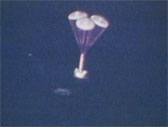


|

|
|
|
Astronomers find new kind of cosmic object CSIRO NEWS RELEASE Posted: February 15, 2006
The new objects - dubbed Rotating Radio Transients or RRATs - are likely to be related to conventional radio pulsars (small stars that emit regular pulses of radio waves, up to hundreds of times a second). But the new objects probably far outnumber their old cousins, the scientists say. Eleven RRATs have been found, first detected by the Parkes Multibeam Pulsar Survey and then observed again several times. Their isolated bursts last for between two and 30 milliseconds. In between, for times ranging from four minutes to three hours, they are silent. "These things were very difficult to pin down," says CSIRO's Dr Dick Manchester, a member of the research team and a veteran pulsar hunter. "For each object we've been detecting radio emission for less than one second a day. And because these are single bursts, we've had to take great care to distinguish them from terrestrial radio interference." By analysing the burst arrival times, the astronomers have found that 10 of the 11 sources have underlying periods of between 0.4 seconds and seven seconds. It is this that suggests that they are rotating neutron stars. Because RRATs are 'silent' most of the time, the chance of being able to detect one is low. Many more must lurk unseen in our Galaxy, the astronomers argue - perhaps a few hundred thousand. The number of 'normal' radio pulsars in our Galaxy is estimated to be about 100 000. Unlike some other kinds of stars that show periodic eruptions, the RRATs show no evidence for being in binary systems (that is, each orbiting another star). A handful of 'normal' pulsars produce the occasional 'giant' pulse, along with their usual train of regular, smaller pulses. The RRATs appear to differ from these pulsars by having magnetic field strengths in the emission region about a hundred thousand times weaker. |
|
|
|
 SFN+Plus Video clip of the day  STS-5: With the four test flights complete, NASA declared the space shuttle a fully operational program. The crews were expanded, commercial payloads were welcomed aboard and the mission plans became much more hectic. This new era began with Columbia's STS-5 flight that launched the ANIK-C3 and SBS-C commercial communications satellites from the shuttle's payload bay. Commander Vance Brand, pilot Bob Overmyer and mission specialists Joe Allen and Bill Lenoir narrate highlights from their November 1982 mission in this post-flight presentation.  Spaceflight Now is pleased to present our new Mission Report Minute video podcast, a free service to bring you the latest news from the space program in a short one-minute bulletin! Spaceflight Now is pleased to present our new Mission Report Minute video podcast, a free service to bring you the latest news from the space program in a short one-minute bulletin!Columbia Report  A reproduction of the official accident investigation report into the loss of the space shuttle Columbia and its crew of seven. A reproduction of the official accident investigation report into the loss of the space shuttle Columbia and its crew of seven. U.S. - U.K. - E.U. - Worldwide |
|||||||||||||||||||||
|
INDEX | PLUS | NEWS ARCHIVE | LAUNCH SCHEDULE MISSION REPORT | ASTRONOMY NOW | STORE ADVERTISE � 2006 Pole Star Publications Ltd |
|||||||||||||||||||||||||||